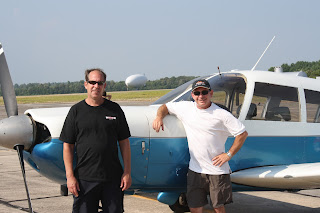Started, or should I say continued my quest to become IFR rated. For those of you who are not steeped in aviation, IFR stands for Instrument Flight Rules (although some would say it means I Follow Roads!). This type of rating is the next step in advancing your piloting skills. It will allow me to fly through weather that you are not allowed to fly through with a VFR (Visual Flight Rules) rating.
An IFR rating is the foundation upon which other ratings are based. It requires ground schooling (which I completed about 18 months ago) and a knowledge test by a certified testing center (which I passed about 6 months ago). Then you must complete the flight training with a Certified Instrument Flight Instructor (CFII) which I started about 7 years ago but had to abandon until I could complete the ground schooling. Hey, some of us just like to take our time… had other things to do. Anyway, I was able to get up with my previous instructor (Rick) and we started out as though it was just yesterday that we were practicing for the check ride… both of us had a little more gray hair, and a lot more stories to tell! There have been a lot of changes in aviation in the last 7 years. For one thing, almost all of the NDBs (non directional beacons) have been decommissioned and GPS has become the norm. However a lot has remained the same… "fly the plane Robin". Rick put me through the paces to see how much I remembered on "flying by instruments". Folks, it was a little tough at first but eventually things were coming back to me. We practiced Slow Flight, Power-on and Power-off Stalls as well as climbing and descending and turning to a particular heading all while under a "hood" (view limiting device). The tolerances are very close (100 feet in altitude and 10 degrees heading). After about an hour, the instruments "get into your head" and one of two things happen… either you become very comfortable with how to make the plane do exactly what you want (almost by instinct) or you start to over analyze how to make things happen and the whole thing becomes a jumbled up mess! Eventually the instinct becomes a normal part of flying. This is why pilots train for hours on end. I have to admit the challenge is exhilarating and I can't wait for the next session! I know I will be a much better pilot with this training… Thanks Rick!
This type of training will make me a better pilot and increase my safety factor as I plan my trip to St. Croix island and the Final Fix mission. Thanks to all who are supporting this nobel cause. Bye for now, Robin.












